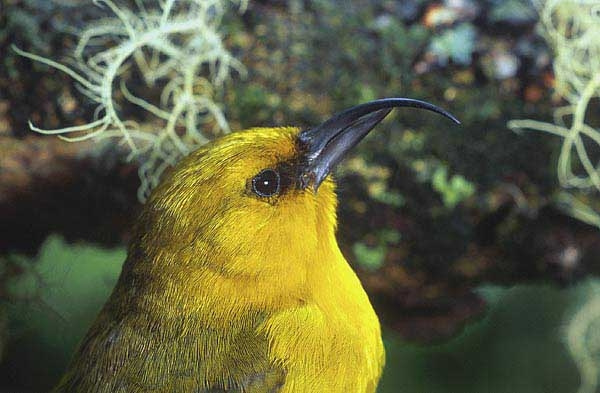By Lindsay Renick Mayer
Using one of the largest DNA data sets for a group of birds and employing next-generation sequencing methods, Smithsonian scientists and collaborators have determined the evolutionary family tree for one of the most strikingly diverse and endangered bird families in the world, the Hawaiian honeycreepers. The researchers determined the types of finches that the honeycreeper family originally evolved from and also linked the timing of that rapid evolution to the formation of the four main Hawaiian Islands.
“There were once more than 55 species of these colorful songbirds, and they are so diverse that historically it wasn’t even entirely clear that they were all part of the same group,” said Heather Lerner, who was a former postdoctoral researcher at the Smithsonian Conservation Biology Institute’s Center for Conservation and Evolutionary Genetics when she conducted this research and is currently an assistant professor of biology at Earlham College and Joseph Moore Museum director.
“Some eat seeds, some eat fruit, some eat snails, some eat nectar. Some have the bills of parrots, others of warblers, while some are finch-like and others have straight, thin bills. So the question that we started with was how did this incredible diversity evolve over time.”
The answer is unique to the Hawaiian Islands, which are part of a conveyor belt of island formation, with new islands popping up as the conveyor belt moves northwest. Each island that forms represents a blank slate for evolution, so as one honeycreeper species moves from one island to a new island, those birds encounter new habitat and ecological niches that may force them to adapt and branch off into distinct species. The researchers looked at the evolution of the Hawaiian honeycreepers after the formation of Kauai-Niihau, Oahu, Maui-Nui and Hawaii. The largest burst of evolution into new species, called a radiation, occurred between 4 million and 2.5 million years ago, after
Kauai-Niihau and Oahu formed but before the remaining two large islands existed, and resulted in the evolution of six of 10 distinct groups of species characterized by different sizes, shapes and colors. These findings will be published in the hard-copy version of Current Biology Nov. 8, with Lerner as lead author. (A PDF version of the paper is available online on Current Biology’s media pages.)
“This radiation is one of the natural scientific treasures that the archipelago offers out in the middle of the Pacific,” said Helen James, a research zoologist at the Smithsonian’s National Museum of Natural History and a co-author of the paper. “It was fascinating to be able to tie a biological system to geological formation and allowed us to become the first to offer a full picture of these birds’ adaptive history.”
James’ previous work on Hawaiian bird morphology, the branch of biology that deals with form and structure of organisms, played a pivotal role in determining which avian species to survey to determine the closest living relatives of the Hawaiian honeycreepers. Using genetic data from 28 bird species that seemed similar to the honeycreepers morphologically, genetically or that shared geographic proximity, the paper’s authors determined that the various honeycreeper species evolved from Eurasian rosefinches. Unlike most other ancestral bird species that came from North America and colonized the Hawaiian Islands, the rosefinch likely came from Asia, the scientists found.
“There is a perception that there are no species remaining that are actually native to Hawaii, but these are truly native birds that are scientifically valuable and play an important and unique ecological function,” said Rob Fleischer, head of SCBI’s Center for Conservation and Evolutionary Genetics and a co-author of the paper. Fleischer has been studying the genetics, evolution and conservation of these birds for more than 25 years.
More than half of the known 56 species of honeycreeper are already extinct. The paper’s researchers focused on the 19—now 18—species that have not gone extinct, but of those, six are considered critically endangered by the International Union for Conservation of Nature, four are considered endangered and five are vulnerable.
The next, ongoing step in the research is to use museum specimens and subfossil bones to determine where the extinct species fit into the evolutionary family tree, or phylogeny, to see if the new lineages fit into the overall pattern found in this study.
The study’s authors from SCBI are Lerner and Fleischer. The additional authors are James from the Smithsonian’s National Museum of Natural History, Hofreiter from the University of York and Matthias Meyer from the Max Planck Institute for Evolutionary Anthropology. The work was funded by the National Science Foundation.








